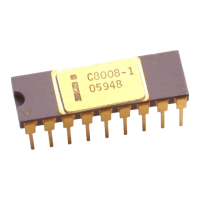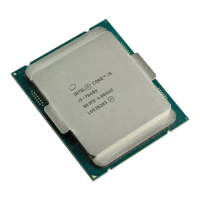Design Guide 77
Memory Interface Routing Guidelines
6.6 Clock Enable Routing
The MCH provides a single clock enable (CKE) signal. This signal is used during initialization to
indicate that valid power and clocks are being applied to the DIMMs. Because the CKE signal has
higher loading, it requires a lower impedance. The recommended impedance for the CKE signal is
40 Ω. This can be achieved using a 7.5 mil wide trace on the recommended stackup (refer to
Figure 6-3). It is acceptable to route the CKE signal 5 mils wide when breaking out of the MCH.
The CKE signal requires a parallel termination resistor (Rtt) to DDR VTERM placed as close to
the last DIMM connector as possible.
NOTE: Indicated lengths measure from the MCH pin to the DIMM connector pin.
Table 6-7. Clock Enable Routing Guidelines
Parameter Intel
®
E7500 Reference
Signal Group CKE
Topology Daisy Chain with Stubs Figure 6-12
Reference Plane Ground Figure 6-3
Trace Impedance (Zo) 40
Ω ± 10% Figure 6-3
Nominal Trace Width 7.5 mil Figure 6-3
Nominal Trace Spacing 15 mil Figure 6-3
Trace Length – MCH to DIMM1 1.8” to 6.0” Figure 6-12
Trace Length – DIMM to DIMM 0.8” to 1.2” Figure 6-12
Trace Length – CKE Stub < 300 mil Figure 6-12
Trace Length – DIMM to Rtt < 0.8” Figure 6-12
Termination Resistor (Rtt) 22
Ω ± 2% Figure 6-12
MCH Breakout Guidelines 5/5, < 500 mil
Length Tuning Requirements To CMDCLK pair: ± 2.0” Figure 6-9
Figure 6-12. CKE Topology
CKE
MCH
DDR VTERM
(1.25V)
DIMMs
DIMM to
DIMM
Rtt
DIMM to
DIMM
DIMM to
DIMM
MCH to DIMM1
DIMM
to Rtt
CKE Stub

